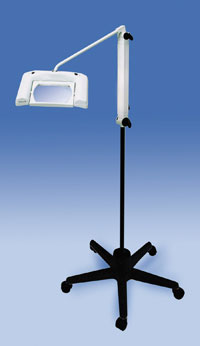Home » Hospital & Durable Medical Equipment » Seeing Is Believing With Magnifier Lamps » Seeing Is Believing With Magnifier Lamps
Seeing Is Believing With Magnifier Lamps

Ring Magnifier Lamp w/ Floor Stand
Retail Price: $663.95
Your Price: $577.28
 Unit: single
Unit: single

OmnivueMax Industrial Magnifier Light w/ Floor Stand
Retail Price: $796.76
Your Price: $697.87
 Unit: single
Unit: single

Omnivue Industrial 27W Magnifier Light w/ Floor Stand
Retail Price: $796.76
Your Price: $696.84
 Unit: single
Unit: single
If you are supplying a medical facility with diagnostic equipment such as magnifier lamps, there are several things you need to know in order to find high quality lamps which will perform at an optimal level to enable the physician to make the most accurate diagnosis. There are several different types of lamps which might be used in a facility, and the final use of the light will determine which type you purchase. In most cases, you will need several of each type of lamp, and by knowing how to find the most cost effective models for the highest possible quality will enable you to provide your physicians will all of the different sorts of magnifier lamps which they might require.
There are three main types of magnifier lamps which might be requested from you by the physician. These are hand-held, wall-mounted magnifiers, and floor magnifiers. All three of these require different amounts of space in which to house them, and they all have different attributes for which you need to look. As different as these three lights are, there are some common traits among them all which will ensure that you are getting the highest quality products possible. For any magnifier lamps, you will need to find a model which offers a wide area of magnification. This will give the user the best viewing space possible and it will minimize the amount which he has to move the lamp in order to see better.
The lamps should also have a bright light on them. Most of them are equipped with energy efficient fluorescent lights. These have the advantage of being cool during use while also having an extremely long life – reducing the cost for replacement bulbs. Unless you make the right selection, though, there can be problems from these. You will need to look for flurescent lamps that have special ballasts in them which enables the lamp to light immediately at its fullest brightness. If you do not, the light will take a few seconds to fully brighten. This could affect the pupil dilation of both the patient and the physician. In either case, their vision will be temporarily affected. The doctor needs all of the visual acuity he has in order to make a proper diagnosis. You selection of a magnifier lamp will either help or hinder the physician in his job.
For the three different types, you also need to look at their specifics. For the smallest hand held units, they should still offer bright lighting. While some of them are tiny enough to fit into a lab coat pocket, there are larger RING models which will not. Ask the doctor what the intended use of the magnifier lamp will be. The smallest are ideal for examining places of a patient's body which might be unreachable by a larger hand held units or a wall or floor mounted model. Wall units should affix firmly to the wall and have an adjustable arm to give them the fullest range of motion. These are perfect for diagnostic rooms where the magnifier lamps will be needed most of the time. If a larger, Wall sized unit is needed, but portability is still required, a rolling floor unit will fill the bill. These can be wheeled from room to room wherever they are needed.
Be sure to look for high quality magnifier lamps when you are making your selection to enable the physician to make the most accurate diagnosis.














